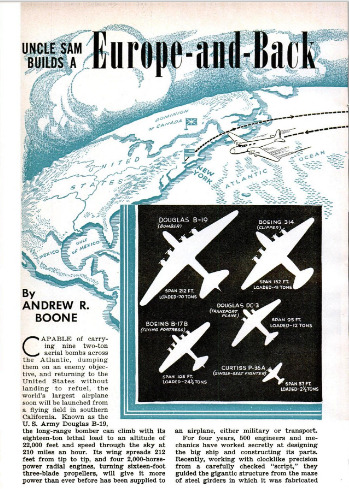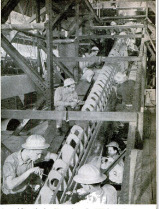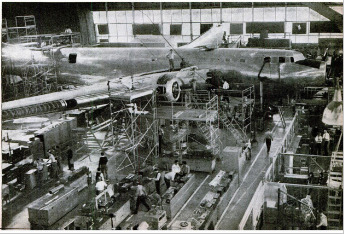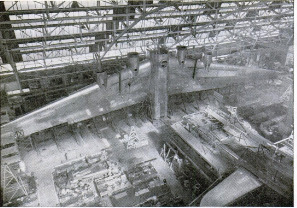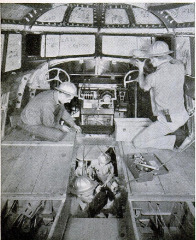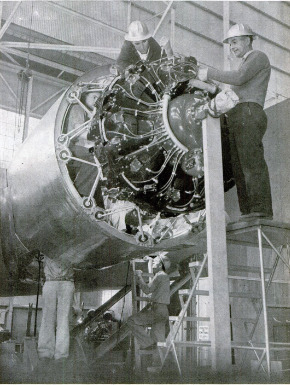U. S. Bombers
Item
-
Title (Dublin Core)
-
U. S. Bombers
-
Article Title and/or Image Caption (Dublin Core)
-
Uncle sam builds a europe and back warplane
-
extracted text (Extract Text)
-
CAPABLE of carry-
ing nine two-ton
aerial bombs across
the Atlantic, dumping
them on an enemy objec-
tive, and returning to the
United States without
landing to refuel, the
world’s largest airplane
soon will be launched from
a flying field in southern
California. Known as the
U.S. Army Douglas B-19,
the long-range bomber can climb with its
eighteen-ton lethal load to an altitude of
22,000 feet and speed through the sky at
210 miles an hour. Its wing spreads 212
feet from tip to tip, and four 2,000-horse-
power radial engines, turning sixteen-foot
three-blade propellers, will give it more
power than ever before has been supplied to
an airplane, either military or transport.
For four years, 500 engineers and me- |
chanics have worked secretly at designing
the big ship and constructing its parts. |
Recently, working with clocklike precision
from a carefully checked “script, they
guided the gigantic structure from the maze |
of steel girders in which it ‘was fabricated
and gently turned the fuselage and wing
from a vertical to a horizontal position.
When the engines are installed and gasoline
poured into the wings, a crew of ten will
test-fly the new leviathan. It will have a
total weight, fully loaded, of 140,000 pounds.
In building the new weapon of the sky,
engineers concentrated on range and strik-
ing power, rather than on speed. Including
a tricycle landing gear and a retractable
nose wheel, the ship is constructed entirely
of metal. Its wheels, eight feet in diameter,
will disappear during flight in huge wells
under the wing. The ship measures 135
feet from nose to tail, and the tail assembly
stands as tall as a three-story building.
Towering forty-two feet above the earth,
the fin alone has an area larger than the
wings of the large twin-
engine transports operating
on the nation’s air lines.
All the huge load of fuel
required to drive the mam-
moth bomber on its long-
range fiights will be carried
in the wings, in self-sealing
cells that will prevent ex-
cessive loss of gasoline if
the wing is punctured by
bullets or shells. Baffles in-
side the fuel tanks keep
the liquid from splashing
about.
Under certain conditions
of weather and load, the
plane will have a range of
7,750 miles. Bristling with
cannons and machine guns,
it will be the most formida-
ble fortress of the air ever
designed. When taken over
by the U.S. Air Corps in a
few months, the B-19 will
be used as a laboratory for
assembling and checking tactical and struc-
tural information from which may be de-
veloped large cargo and troop transports
for the future.
Just as the Army's pioneering with the
“Flying Fortress” paved the way for the de-
velopment of the mammoth four-engined
stratoliners, so the contruction of the B-19
may blaze the trail for larger commercial
sky liners. It may not be long before a
plane like the B-19 will be carrying passen-
gers across the Atlantic. Already, Pan
American Airways is planning an ocean
service with seventy-ton, - 150-passenger
ships. In the conquest of the air, wings of
peace follow the wings of war.
-
Contributor (Dublin Core)
-
Andrew R. Bonne (article writer)
-
Language (Dublin Core)
-
eng
-
Date Issued (Dublin Core)
-
1940-12
-
pages (Bibliographic Ontology)
-
56-59
-
Rights (Dublin Core)
-
Public domain
-
Archived by (Dublin Core)
-
Sami Akbiyik
-
Marco Bortolami (editor)
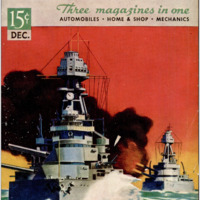 Popular Science Monthly, v. 137, n. 6, 1940
Popular Science Monthly, v. 137, n. 6, 1940

